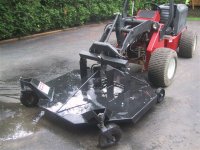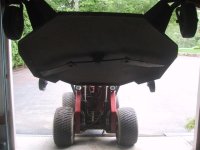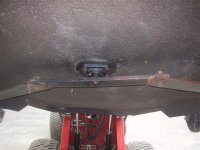While the spindle looks small on the larger unit, the spindle on our PT425 48" brush cutter is just as small... about a 1" shaft. The difference is on ours the big round can attaches to the spindle, and then the blades attach to the can. On the 60" cutter as shown in theprevious posts appears to have a bar, instead of a can, that the blades are attached to. They still swing freely from pivot points like the ones attached to the can.
I have lost blades twice on my 48" cutter by hitting hidden rocks. The bolt head sheared off. The first time, the blade stayed under the unit. The second time, it flew forward about 10 feet.
The 48" unit is front discharge. This design is nice, because as you travel forward, most of the stuff is cut before the center of the spindle gets past it. Most of the stuff is discharged in a pattern to the front and right of the unit(may be left, I forget which way it rotates). However, chips and stuff will fly out in any direction, given the violent nature of the destruction going on under that beast. With the unit on the ground, anything that flies out the rear and doesn't go under the tractor will be stopped by the thick steel on the front of the tractor. As long as the operator is not hanging over the steering wheel trying to look down to see the rear of the brush hog, there is little chance they will be hit by flying debris. Too much steel in the way. I've had a brush hog on a conventional tractor, and just as much stuff came out in all directions as the PT unit, so I think that point is a tie.
I once hit a piece of hidden steel in tall grass. I flew out the back and shattered the left, rear wheel on the brush hog, then ricocheted forward out onto a highway. Thank goodness I had the sense to not mow with any cars around.
No sheer pins. No drive shaft to get caught in, either. /forums/images/graemlins/wink.gif
I believe the brush hog is the most dangerous piece of tractor equipment made. When used properly, it is a great tool, but it needs proper respect.


